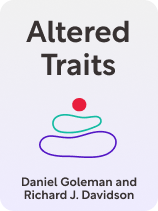

This article is an excerpt from the Shortform book guide to "Altered Traits" by Daniel Goleman and Richard J. Davidson. Shortform has the world's best summaries and analyses of books you should be reading.
Like this article? Sign up for a free trial here.
What are some of the issues with meditation research? Should we believe all the hype?
Meditation research is a rapidly growing field, but it faces unique challenges. Scientists are working to understand how different forms of meditation affect the brain and behavior. They’re also trying to develop better ways to measure these effects.
Let’s explore the foundations of meditation research, common misconceptions, and why it’s important to approach claims about meditation with a critical eye.
Meditation Research
Daniel Goleman and Richard Davidson are psychologists, writers, and lifelong meditators who helped pioneer research on meditation in the modern West. In their book Altered Traits, they argue that meditation has been challenging to study. Meditation research is a young and rapidly growing field, and much of the difficulty in understanding meditation arises from confusion about what it is, how to distinguish the forms it takes, and how to properly measure its effects.
We’ll detail the broad basis for meditation research (neuroplasticity, or the brain’s innate ability to adapt to stimulation). We’ll also describe the common misunderstandings and mistakes made in meditation research. Last, we’ll explain why it’s crucial to remain vigilant against hype when evaluating research and claims about meditation.
The Basis for Meditation Research
When the authors first pushed to study meditation, the conventional academic perspective was against them. Most serious research scientists thought that meditation was too subjective or woo-woo, and that the mind was a black box—impossible to study rigorously.
Despite this resistance, the authors hypothesized early on that meditation could produce the titular “altered traits”—lasting changes to people’s basic characteristics. Depending on how you meditate, these can include increased stress resilience, emotional intelligence, and cognitive capacities such as attention, focus, and more.
Early on, the techniques available to measure the effects of meditation weren’t effective enough. However, the discovery of neuroplasticity provided a broad, scientifically viable basis for their research.
Neuroplasticity is the brain’s ability to change in response to some activity or stimulus. For instance, research on rats found that their brain health worsened after they were merely placed closer to unhealthy rats. When it comes to meditation, the discovery of neuroplasticity made it reasonable to claim that meditation could alter the brain. And as it turns out, the authors explain, the mental training of meditation does physically modify the structure, size, and functioning of brain tissue. As a result, traits that relate to those brain changes can shift as well.
Mistakes & Misconceptions in Research
Despite this evidence of the positive effects of meditation, it remains difficult to study. Research on meditation varies in quality, and mistakes and misconceptions can stand in the way of rigorous work.
Mistaking the Peaks for the Path
According to the authors, many researchers mistake the highs that meditation produces—states of deeply absorbed awareness, for instance—for the whole thing. However, they say, these highs are just temporary states that are more akin to an exercise high than a lasting gain in meditative capability.
For another analogy, consider weightlifting. When you work out, you get a pump—a temporary increase in the size of your muscles. But these pumps aren’t your gains—the lasting increases in the size and function of your muscles. In meditation, the high states are the pumps and the gains are the altered traits. When research focuses on temporary peaks as outcomes, it misses the broader picture of meditation as a long-term process with long-term aims.
(Shortform note: One reason that some Western researchers may have mistaken meditative highs for lasting gains is that, in the West, people tend to focus on goals and outcomes rather than processes—ends, rather than means. This may reflect the “protestant ethic” that Max Weber argues gave rise to the productivity-oriented culture of the United States. Perhaps because of this cultural bias toward tangible goals, some Western researchers struggle to see meditation as a life-long practice with many intangible features—like deeply personal realizations reached while sitting—that can’t be measured or quantified.)
Researcher Bias
Another issue is researcher bias, wherein the person conducting the study may unconsciously design the experiment, interpret the findings, or otherwise skew outcomes in ways that support their hypothesis. Goleman admits that, in doing his own research, he once skewed the results by expecting what he wanted to see and then interpreting the data to fit those hopes.
(Shortform note: According to Rolf Dobelli in The Art of Thinking Clearly, cognitive biases feature throughout our lives in ways we rarely, if ever, notice. One bias that can affect research is the “story bias,” in which we tend to prefer satisfying narratives over boring, rational facts. In studies where the data might suggest a pattern, but also might not, this bias could lead a researcher to find meaning where there may be none. Another relevant bias is the self-selection bias, wherein only people who feel comfortable participating in studies tend to do so. For example, the participants in a study could skew toward people who already practice meditation, so the study’s results wouldn’t reflect how meditation might affect the general population.)
Misunderstanding “Mindfulness”
Another key mistake arises from the ambiguity surrounding the term “mindfulness.” Many studies take it as a catchall term for meditation. According to the authors, it was originally meant as a translation of sati (the path of insight that the Buddha taught). However, it’s often incorrectly conflated with vipassana, the practice by which many Western meditators practice sati.
Because of the range of studies that have used mindfulness as a general term, it now means a wide variety of things. Accordingly, the authors say that many studies mistakenly lump research subjects who come from different meditation backgrounds into one general category. Because of this, the research isn’t precise enough to draw useful conclusions from.
For instance, a study might lump together practitioners from Zen, traditional Theravada, Tibetan Dzogchen, and Western mindfulness methods, thinking they’re essentially the same. But they aren’t—and, because the study doesn’t distinguish between them, the authors would likely say that the results aren’t rigorous enough to support firm assertions.
(Shortform note: Perhaps inspired by the authors’ ideas above, a 2021 analysis published in the journal Mindfulness took on this very issue. The authors compiled over 300 distinct forms of meditation and categorized them into 50 fundamental techniques. They then asked over 600 experienced meditators to evaluate this set of techniques for completeness. Only two more had to be added, resulting in a new taxonomy of meditation that can be used as a tool for any future studies to get more precise about what they want to study, as the authors stress must happen.)
Hyperbole & Exaggeration
Although the rapidly increasing interest in meditation is a positive development, the authors explain that, more than ever, we must remain vigilant against hype.
Fields with spiritual roots, such as this one, are prone to frauds and huckster. Today, businesses and advertisers are keen to cash in on the excitement. Many will overpromise the benefits of their products to sell apps, courses, and other tools. For these reasons, the authors stress the need to remain skeptical and rigorous in evaluating the data and determining what’s actually true about meditation.
(Shortform note: Marketing has both upsides and downsides when it comes to mindfulness. On the upside, Western-style marketing has unarguably spread mindfulness and meditation to a larger audience than ever before. This has led to countless adaptations of the techniques that have helped people reduce stress, feel more at peace with life, and generally improve their well-being. On the downside, some argue that all of this marketing has spawned “McMindfulness,” a co-opting of these techniques for nefarious purposes. For instance, one expert argues that corporate mindfulness training serves to pacify an increasingly stressed, depressed, and disengaged workforce and, in doing so, shifts attention away from the systemic causes of these issues.)
According to the authors, the most widely touted benefits of meditation aren’t all they’re cracked up to be—and the benefits that are most supported by research remain undersung.

———End of Preview———
Like what you just read? Read the rest of the world's best book summary and analysis of Daniel Goleman and Richard J. Davidson's "Altered Traits" at Shortform.
Here's what you'll find in our full Altered Traits summary:
- How the West has distorted true meditation
- Why meditation is so difficult to study
- The 5 proven benefits of having a meditation practice






